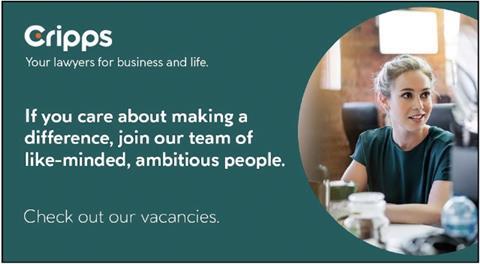The UK legal market continues to consolidate with at least 15 mergers involving top-200 firms in the last year. Recent examples include the acquisition of Coffin Mew by Knights, Ampa’s acquisition of Mayo Wynne Baxter and Royds Withy King merging with Goodman Derrick.

For some of these mergers, there is an expectation that the smaller firm will assume the bigger firm’s name, processes and culture; for others, they might keep their brand name and enjoy the benefits of being part of a larger infrastructure and umbrella organisation. No M&A strategy comes without risks and challenges, and a mismatch of cultures is a common cause of failure. Subsuming firms often leads to heavy staff losses if people dislike the acquiring firm’s culture. Equally, a portfolio of individually branded, smaller firms has the potential to feel disparate and disconnected.
In December 2018, Cripps merged with Pemberton Greenish. On the face of it, the firms seemed like unlikely bedfellows – a mid-sized regional law firm focused on institutional investors, entrepreneurial businesses and their owners; paired with a boutique Chelsea firm renowned among London’s prime landed estates.
However, scratch beneath the surface of the bold orange or sage-green logos, and the firms’ combined strengths and shared beliefs became more evident. From the outset this merger was not about imposing one firm’s views or culture on the other, or keeping them separate, but taking the best attributes from both and blending them to create the new Cripps.
The first challenge was to bring the combined benefits and values to the fore, so that everyone in the newly merged firm felt like they were part of the same team, unified by the same purpose, vision and values.
In 2019, following the initial integration of systems and processes, the firm appointed a brand consultant to help identify what makes us what we are. Feedback was gathered from facilitated focus groups across both offices. After much distillation, findings were grouped into four key attributes that our people valued most – care, imagine, achieve and enjoy. From these stemmed a more detailed narrative, to help people understand how they applied in the context of colleagues, clients and the wider community.
However, words mean little in themselves so the firm established working groups to embed the values into our everyday lives. These included the reward and recognition scheme, agile and flexible working practices, the technology strategy, approach to client engagement, and community and charity involvement.
When the world shifted with the impact of Covid-19 and people were required to work from home, it put the newly established values to the test. However, rather than fall by the wayside, the opposite happened and the values of ‘care’ and ‘imagine’ particularly came to the fore. People found innovative new ways to help their colleagues and their clients.
In 2020, the firm relocated its London office from Chelsea to Victoria. Employees were consulted on how they would like to work and just 10% of staff wanted to return to the office full-time. Therefore, the new office was designed to create a vibrant, open and collaborative working environment with the flexibility to suit different working practices.
As with any successful partnership, moving a new partner into the old marital home is never ideal. Creating a fresh new space, with no legacy-firm memories, marked a milestone in the firm’s evolution and was a physical manifestation of who we had become. Having engaged with our people throughout the process, they were able to collectively enjoy the London office that they helped to co-create.
The final piece of the integration puzzle was to develop the new brand and visual identity which reflected the merged firm. Following the London office move, extensive research with our people and clients was undertaken to understand their perceptions of our brand and what matters to them. From this, a clear and succinct vision was developed, underpinned by the four values. We took this opportunity to review the values created immediately after the merger, to ensure they still aligned to our strategy and resonated with our people three years later. Despite how much has happened since then, feedback showed that the values had stood the test of time and continue to be regarded as the bedrock of who we are. This informed the tone of our brand messaging and the creative concept that sits behind the firm’s new visual identify.
Ordinarily, following a merger, the rebrand swiftly follows. However, because the firm had to prioritise its response to the pandemic, it enabled more time to bed in, aligning philosophies and gaining a much better understanding of what we wanted the blended firm to be for both our people and clients. Talking about legacy firms has now become a thing of the past and, as we forge ahead with a distinctive new brand which our people are excited and energised by, the new Cripps embodies the best from both businesses.
Rachel Smith is director of business development and marketing at Cripps































No comments yet